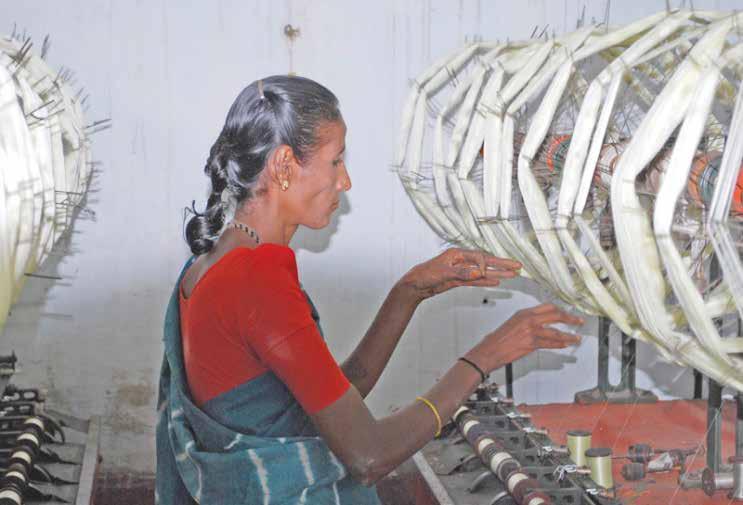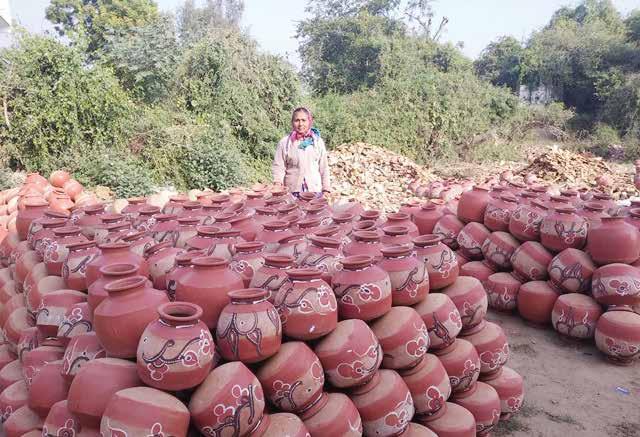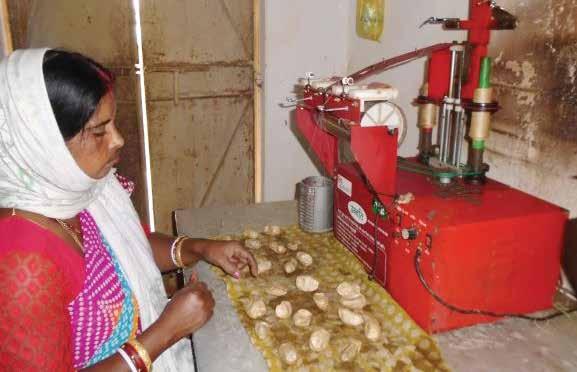
4 minute read
FIGURE 4: Silk thread twisting process
4.1.2 Sidlaghatta Silk Twisting Cluster
Cluster profile
Advertisement
Karnataka is one of the major states for mulberry silk production in India. Sidlaghatta taluk in Chikkaballapura district is a prominent town and famous for trading of huge quantity of silk cocoons and twisted silk to other Indian cities. There are around 1200 home-based silk twisting units in Sidlaghtta cluster. The twisted yarn is in great demand among silk thread buyers, mostly from Kanchi, Harni, Dharmavaram, and Bengaluru. These buyers can also be silk saree and other silk apparel-making agencies.
The twisting units normally operate for 10–12 hour in a day and the production continues throughout the year in all the seasons. The small units (120–200 spindle) represent 80% of the total twisting units in the cluster, while the balance 20% are large units (500 spindle and beyond). These big units were found highly energy intensive, thus were not covered under the study. The average monthly revenue of small unit varies from INR 45,000 to INR 75,000 based on their volume of productions (100–150 kg of silk yarn).
Production process
Twisting is a process of preparing raw silk with desired strength and thickness for textile weaving in the loom. Normally, raw silk is extracted from the cocoons and then served into the reeling basin. The reeled silks are called skeins. These skeins are then wound onto bobbins through a winding machine. The wound yarn is then ‘doubled’, wherein threads from two separate bobbins simultaneously run onto a single bobbin, which is then taken for twisting. The twisted threads are
FIGURE 4: Silk thread twisting process
spooled onto bobbins, which are ready to be taken for weaving silk products. The major technologies used in the processes are winding machine, doubling machine, and twisting machine. The cumulative electrical capacities of these machines are 3 HP. The machines can be operational for 30 years, provided proper maintenance is done. An average monthly maintenance cost of INR 600 is incurred by the entrepreneurs.
Energy consumption
In this cluster, grid power is supplied without much interruption except occasional power cut. However, during the summer and rainy seasons, the power cut increases by up to 2–3 hour a day. Though the overall power supply is satisfactory in the region, power generation from solar would further reduce the power subsidy burden of the department. The weavers interviewed in the studied cluster expressed their interest in exploring the option of solar PV to reduce their current electricity bill. They were also willing to provide the available space for installation of the system and make partial capital contribution.
Design of solar PV
In this cluster, 4 kWp grid-fed individual solar PV system has been proposed (without battery backup) for each and every twisting unit. The design of the system has been done considering the space constraint and investment capacity of the studied cluster. Thus, it has been assumed that 50% of the energy will be met through solar and balance 50% will be met through the grid. The area requirement for solar installation is around 27 m2. Currently, the monthly average electricity expense is around INR 3500 out of which INR 2100 (60%) is paid by District Industry Centers (DIC) and the balance, approximately INR 1400 (40%), is paid by the unit owner. Introduction of solar PV in these units is expected to save monthly electricity bill of around INR 1750 (approximately 50% of the current electricity bill) that includes the monthly savings of power subsidy of INR 1050 per unit. Thus, power subsidy savings would be around INR 60,000 if assessed for a period of 5 years. Increase in productivity and revenue due to solar have not been assessed since daily working hours are not expected to increase much except partial gain during summer and rainy seasons.
Proposed business model
To introduce solar PV in the cluster, the investment would be around INR 216,000 for each and every unit (based on benchmark price (INR 54 per Wp) of grid-tied solar PV system notified by the MNRE, Government of India). The DIC can take a lead in arranging maximum subsidy of 40%–65% for incentivizing the entrepreneurs for solar installation so that the department can avoid recurring subsidy burden on electricity. Based on the analysis, the upfront subsidy proposed will be less than the power subsidy for 5–7 years (as per the current rate of power subsidy, i.e. 60% of the total electricity bill). While 20% would be mobilized from the unit owner, the balance 30% is proposed through loan from commercial bank or other financing institution. The most popular PMMY scheme can be explored for availing Mudra loan. A few scenarios have been worked out considering different proportions of subsidies and bank loans that may be offered to the unit owners, to make the solar system affordable. However, the feasibility of solar has been found only in the following scenario: In this cluster, without subsidy component, and with an upfront investment of 20% of the hardware cost and loan component of 80% of the overall hardware cost, payback is estimated to be more than 10 years. However, with an upfront equity investment of 20%, loan (for 5 years) amounting to 30% of the total hardware cost, and a capital subsidy of 50% on hardware cost, the payback period is 4.83 years when a bank loan is disbursed at 8% interest rate per annum and it is 5.2 years when a bank loan is disbursed at 8% interest rate per annum.




